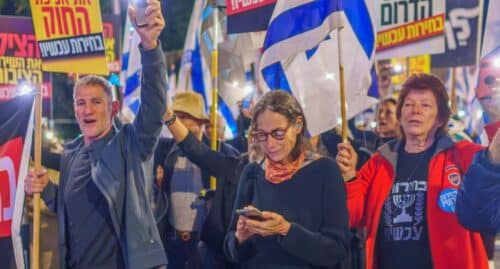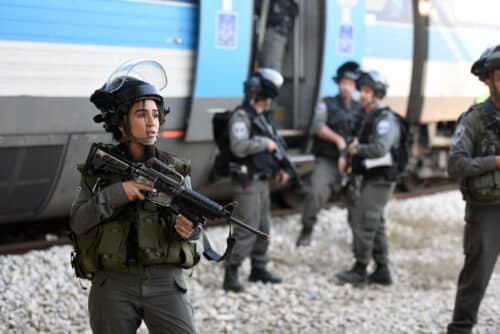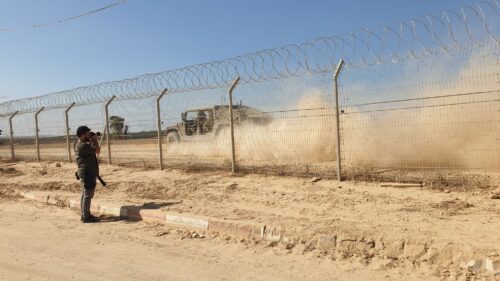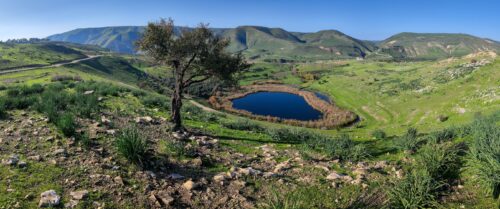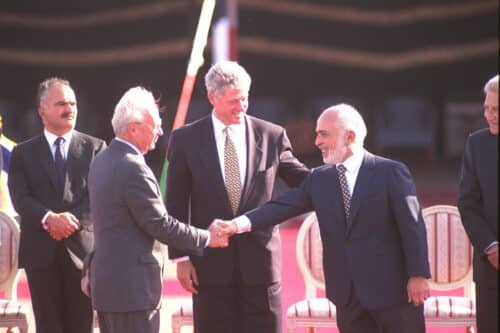Operation “House and Garden” in Jenin marks a positive shift in the mindset of the Israeli political and military leadership. With Israel struggling to effectively combat the wave of terrorism in Judea and Samaria, particularly in the northern region of Samaria, alternative approaches were deemed necessary.
In recent years, Jenin has regrettably reemerged as a major stronghold of terrorism in Judea and Samaria, alongside Nablus. Israel had attempted to entrust the Palestinian Authority (PA) with managing the area and maintaining order, but, as in the past, the PA failed to address the challenges posed by the residents of Jenin refugee camp. The Palestinian Authority’s shortcomings, coupled with the persistent incitement from Hamas, Islamic Jihad, and the Palestinian Authority itself through the educational and cultural systems, as well as the new generation in Jenin lacking an understanding of Operation “Defensive Shield” in 2002 and the repercussions of the second intifada, have contributed to the city becoming the most dangerous and central hub for terrorism in the region.
A main operational situation room was established in Jenin, serving as the operational center from which terrorists orchestrated attacks against IDF forces. The headquarters served as a gathering place for armed terrorists before and after their activities, an area for weapon and explosive storage, and a communication hub for the militants. Additionally, many terrorists sought refuge in Jenin, assuming it would provide safety. Consequently, the city transformed into a fortified terrorist base, replete with checkpoints, roadblocks and roadside bombs.
During the two-day operation (from July 3 to 5), 12 terrorists were killed, over 300 suspects were apprehended (including 30 who were wanted), numerous explosives, weapons, and ammunition were confiscated or destroyed, including underground explosive laboratories, and terrorist funds were confiscated. However, this operation merely represents the beginning of the called-for change of course, and was not extensive or comprehensive enough to tackle the pervasive terrorism in Jenin. It was intentionally designed for more “modest” objectives. Therefore, similar to the “Break the Wave” approach, it is not accurately characterized as a full-fledged “military operation.” The distinction between a military operation and a military activity is also evident in the number of combatants involved. In the current operation, the IDF deployed a single central combat brigade (“Oz”) compared to the five divisions and thousands of reserve soldiers deployed during the “Defensive Shield” operation.
The “House and Garden” military activity differs from the “Break the Wave” military activity in several aspects, signifying a shift in the perspective of Israel’s decision-makers. Firstly, the “House and Garden” activity spanned two consecutive days without interruption, whereas the “Break the Wave” activity was a daily punctual and non-continuous effort. Secondly, the military activity within Jenin as part of “House and Garden” delved deeper than the day-to-day “Break the Wave” activity. Thirdly, the intensity of the firepower and measures employed in Jenin during “House and Garden” surpassed those of the “Break the Wave” activity, which focused on thwarting real-time terrorist operations and serving as a means of apprehending suspects following attacks.
Another noteworthy development within the framework of “House and Garden” was the utilization of airstrikes in the Jenin area through the use of drones, UAVs, and attack helicopters. This marked a highly unusual occurrence that had not been witnessed since the days of the Second Intifada. Thus, it indicates a significant shift in the way Israeli decision-makers perceive this theater.
The objectives of the “House and Garden” military activity
The objectives of the “House and Garden” military activity were primarily focused on enhancing the IDF’s operational freedom and its capacity to counter terrorism in the Jenin area. Over the past year and a half, the IDF has faced significant and determined resistance whenever it has conducted counter-terrorism operations in Jenin. Additionally, barricades, checkpoints, nets spread out on rooftops, and explosive devices were placed to impede the IDF’s movements.
It is important to note that the goals of this activity were primarily tactical in nature, with limited strategic or political dimensions. The main objective led to the derivation of secondary goals, which included damaging terrorist infrastructure, particularly targeting munitions and rockets laboratories and blocking roads with explosive devices. Additionally, the activity aimed to disable the surveillance cameras utilized by the terrorist organizations in Jenin to plan and coordinate attacks against IDF forces.
Therefore, the activity had no intention or dimension of decision. Instead, it served as foundational preparation for potential future military activities. These could either continue as an extension of the “Break the Wave” activities, escalate into a more intensive operation resembling the “House and Garden” activity, or evolve into a larger-scale military operation akin to “Defensive Shield.” The IDF spokesperson emphasized the need for continued operations, stating that they would return to the refugee camp when intelligence indicated the presence of operatives or wanted individuals planning acts of terrorism.
Consequently, one of the sub-goals of the operational activity was to minimize casualties among terrorists (and avoid civilian casualties), presumably with the aim of preventing escalations in both the Judea and Samaria territories, the Gaza Strip, and potentially the northern region. Israel also sought to obtain and maintain international legitimacy throughout the activity.
For example, Captain D, the commander of the UAV formation involved in the military activity in Jenin, explained that the aerial attacks were not solely aimed at targets. Rather, they were primarily conducted to eliminate threats to ground forces. He further stated that during missions with the commando brigade, they identified armed groups that posed a danger to the forces and conducted flyovers to encourage them to disperse, which they indeed did. Another IDF officer stated that the objective was not to achieve a high body count of 200 dead terrorists, as the operation focused on dismantling significant terrorist infrastructures that were identified and destroyed.
Analysis of the tactics in the “House and Garden” military activity
Accumulation of ground-operational experience
The “House and Garden” military activity involved the deployment of a substantial ground force, showcasing a relatively significant accumulation of operational experience in a demanding setting.
The IDF activated a two brigade combat team (BCT) consisting of Golani fighters, Nahal, paratroopers, the commando brigade (“Oz”), and a Harob battalion. These forces were supported by defensive and logistical assistance from the Menashe territorial brigade. This level of force deployment had not been witnessed since Operation Defensive Shield in 2002. The activity’s relatively high intensity, compared to previous operations in the region, provided the opportunity for the forces to engage in combat scenarios resembling a military operation. This stands in contrast to the primary tasks typically assigned to the commando brigade and other combat brigades, such as ongoing security measures or night arrests. Consequently, the combatants gained valuable ground operational experience, particularly in maneuvering through densely populated and complex areas, which could serve in a future counter-terrorism operations or decisive campaigns in Judea and Samaria, the Gaza Strip, and even Lebanon.
Deepening and enhancing the Utilization of UAVs and Drones
The “House and Garden” operation witnessed extensive and refined use of UAVs and drones, as in recent military operations in the Gaza Strip, such as “Shield and Arrow” (2023) and Breaking Dawn (2021).
The continued and intensified use of these capabilities within the “House and Garden” military activity allowed the IDF to accumulate operational experience, enhance operational efficiency, and improve coordination between ground forces and UAV’s operators.
However, the employment of UAV’s in Jenin differed from their usage in the Gaza Strip or in the northern arena. In Gaza and the northern arena, drones and UAV’s are primarily utilized for targeting terror operatives, damaging terrorist infrastructure, and gathering intelligence. However, in Jenin, the IDF employed drones and UAV’s primarily for the purpose of clearing hostile elements from zones warfare, thereby assisting ground combat forces in advancing through densely populated refugee camp. These assets provided real-time intelligence to ground forces and aided in distinguishing between armed terrorists and innocent civilians.
Furthermore, the “House and Garden” military operation introduced the use of “suicide” drones “Maoz”. These drones were employed by fighters from the commando brigade’s units for targeting terrorist objectives near the Jenin refugee camp.
Overall, the comprehensive utilization of UAVs and drones in the “House and Garden” military operation allowed the IDF to refine their operational techniques, enhance effectiveness, and support ground forces in their mission to neutralize threats while minimizing civilian casualties.
Enhancing Organizational and Operational Jointness
The “House and Garden” military operation significantly bolstered the organizational and operational jointness capabilities of the IDF with other security and intelligence agencies, in an environment resembling that of a military operation. While the IDF collaborates with these organizations on a daily basis, primarily focusing on counterterrorism and law enforcement activities, in the “House and Garden” activity, the integration and cooperation between the IDF’s IOS Division, Shin Bet, and police demonstrated exceptional capabilities. This cooperation was evident in the provision of accurate and reliable intelligence by the Shin Bet, including accompanying the forces in the warfare zone, as well as coordination and joint operations between the Border police, police Special Forces, and IDF units during combat operations.
Furthermore, the “House and Garden” activity displayed operational integration within the IDF itself, which had not been seen to such an extent for quite some time, particularly in terms of the size of forces deployed in the field. In recent years, integration efforts within the IDF had predominantly focused on aspects related to the operation of the air force, armored and artillery, particularly in the Gaza Strip. However, the activity in Jenin provided an opportunity to practice deep maneuvering into the enemy’s core areas, highlighting the cooperation between the engineering corps, infantry, armored units, and the air force. Simultaneously, the IDF demonstrated a high level of integration concerning the coordination and synchronization of drones and UAVs, as well as communication and information sharing between armored forces, commando units, and the air force. This encompassed both the execution of attacks and the acquisition, analysis, and dissemination of intelligence. Additionally, effective communication and updates were maintained between the various troops and battalions operating in the narrow alleyways of Jenin.
Overall, the “House and Garden” military operation marked a significant advancement in organizational and operational jointness, facilitating seamless cooperation among the IDF, security agencies, and various units within the military. This enhanced level of integration played a vital role in achieving the operation’s objectives.
Heightened Intelligence Capabilities
The IDF, along with other security forces, showcased exceptional intelligence capabilities in Jenin during the “House and Garden” operation. These capabilities provided accurate and reliable intelligence products crucial to the mission’s success. For instance, the IDF possessed a detailed intelligence picture of the trapped roads in Jenin, enabling the destruction of approximately two to three kilometers of trapped roads out of 13 kilometers of roads within the refugee camp. This precise intelligence significantly minimized infrastructure damage by preventing broader destruction.
The Shin Bet played a key role in providing precise intelligence throughout the operation. They possessed in-depth familiarity with the refugee camp’s terrain, guiding combatants to the locations where explosives were concealed and identifying and tracking individuals involved in terror activities. The Shin Bet’s intimate familiarity with the area facilitated effective field coordination, directing forces through narrow alleys and pathways amidst residential and mine areas.
The intelligence depth achieved during the operation was a testament to the Shin Bet’s field coordinators’ expertise and understanding of Jenin’s intricate network of alleys and roads. Their deep knowledge allowed for seamless navigation and guidance of the forces operating on the ground, ensuring their safety and success in negotiating complex urban environments.
The Accomplishments of the Military Operation in Jenin
The “House and Garden” military operation, being a relatively short and narrowly defined activity, primarily achieved tactical objectives. The notable accomplishments of the operation include:
Firstly, the IDF successfully destroyed significant military infrastructure and weapons capabilities, effectively disrupting the production of locally manufactured rockets. This achievement curtailed the potential threat posed by these weapons.
Secondly, despite engaging in combat within a densely populated and complex urban environment, the IDF managed to conclude the operation without causing any innocent residents been killed. This outcome highlights Israel’s commitment to minimizing civilian casualties and protecting non-combatants. It is noteworthy that despite this policy and impressive achievements, significant voices in the international community, including the European Union and the United Nations, accused Israel of excessive force or even “extrajudicial killings”, as the EU envoy to Israel said, and defined a 17-year-old armed terrorist who was posing a threat to the soldiers as a “child”. This manifested either lack of familiarity with facts on the ground, or stubborn ideological opposition to any self-defense operation Israel would take.
Thirdly, Israel did garner support from the United States for its actions during the operation, demonstrating diplomatic success in securing international backing.
Fourthly, Israel effectively contained the battle within the confined area of Jenin refugee camp, preventing the conflict from spreading to other parts of Judea and Samaria or triggering a civil uprising. Furthermore, Israel successfully averted the much-discussed “unification of fronts”, or the opening of another front of hostilities, whether from the Gaza Strip or the northern region. Although there were some rocket launches from Gaza towards the end of the operation, Israel responded with measured military actions to maintain control and minimize escalation.
Lastly, Israel achieved a certain degree of deterrence against terrorist organizations in Judea and Samaria, though not to a significant extent. By demonstrating the ability to launch unexpected operations against terrorist strongholds like Jenin, Israel aimed to convey a message of its capability and resolve to combat terrorism.
It is essential to recognize that this military operation was focused and limited in scope. Therefore, the achievements should be evaluated proportionally, considering the specific objectives and constraints of the activity.
“House and Garden” military activity – a step toward further action
The “House and Garden” activity signifies a shift in perception among Israel’s leaders, but in and of itself it is insufficient in order to achieve significant deterrence and disrupt terrorist organizations in Judea and Samaria, particularly in Northern Samaria and Jenin. Israel must capitalize on the groundwork laid during this operation to take more aggressive action against terrorism in Jenin and, subsequently, in Nablus. Therefore, the conclusion of the “House and Garden” military activity marks the end of the beginning, signaling the need for the next phase.
It is anticipated that the results of the activity will lead to a temporary reduction in terrorist activities targeting IDF soldiers and Israeli citizens from the Jenin area. However, given the operation’s time, space, and depth limitations, it is likely that terrorist organizations will regroup and regain strength in the near and medium term, seeking to restore their military capabilities in Jenin.
Consequently, in the near and medium term, the IDF must continue launching airstrikes against terrorists and their infrastructure in Judea and Samaria. The focus of the IDF’s offensive and air-based operations should be on Jenin and Nablus. Additionally, regular military raids on Jenin are necessary to prevent the resurgence and rebuilding of terrorist organizations, including their rocket and explosive manufacturing facilities.
Simultaneously, in the longer term, the IDF should develop comprehensive plans for an extensive military operation in Jenin. This operation would involve deploying significantly larger ground and air forces to penetrate deep into the refugee camp, targeting a substantial number of terrorists and the leadership of these terrorist organizations, which represent the enemy’s center of gravity. This operation would be akin to the “Defensive Shield” military operation but limited to the Jenin area only. Subsequently, a similar plan would be required for the Nablus area, another significant terrorist stronghold in Northern Samaria.
By pursuing these strategic actions, Israel aims to dismantle terrorist infrastructure, eliminate key operatives, and ultimately enhance security and stability in the region.
The views expressed in this article are those of the author and do not necessarily represent the views of the movement

